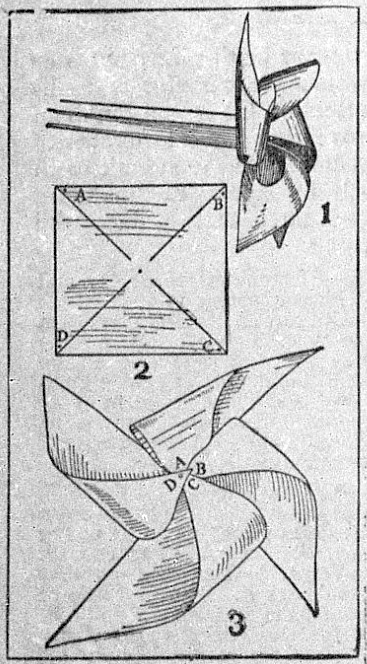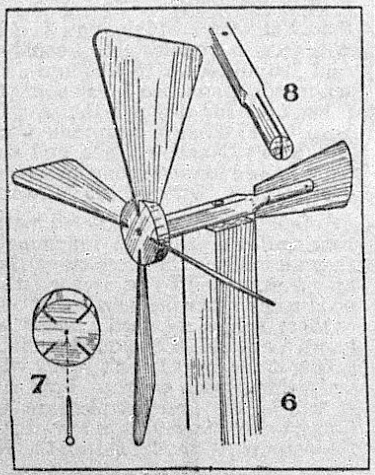
The following article shows how to make a pinwheel and two toy windmills. This was originally published in a newspaper in 1916.

Toy Windmills
The simplest windmill to make and one of the best whirlers ever devised is the common paper pinwheel mounted upon a stick (fig.1).

A piece of paper 8 or 10 inches square is needed for the pinwheel. Fold this piece of paper diagonally from corner to corner, both ways. Then open the paper and with a pair of scissors cut along the diagonal creases from the corners to within 1 inch of the center (fig. 2). Then one by one fold corners A, B, C, and D over to the center, as shown in fig. 3, and run a pin through the corners and through the center of the sheet.
The windmill in fig. 4 may be made of cardboard or tin. A circular piece 10 or 12 inches in diameter is required. After marking out the outer edge with a compass, describe an inner circle about 1 inch inside of it; then draw two lines through the center at right angles to each other, and another pair at an angle of 45 degrees to these. The four lines are indicated by heavy lines in fig. 5. One-half inch to one side of these lines draw a parallel lines, as indicated by dotted lines in fig. 5. The next thing to do is to cut out the disk, and cut through on the heavy lines just as far as the lines are shown on the diagram (fig. 5), and then to fold on the other, or dotted lines.

The hub for the windmill shown in fig. 6 is a block of wood 4 inches in diameter and one inch thick (fig. 7). Draw two lines across one face, through the center, and at right angles to each other. Then carry these lines across the edge of the block, not at right angles to the sides, but at an angle of 45 degrees. Saw along these lines to a depth of 1-1/2 inches. The ends of the windmill blades are to fit in these slots. Cut the blades of equal size, 9 inches long, 5 inches wide on the wide edge, and 1-1/2 inches wide on the narrow edge, and fasten them in the slots with nails. The hub block, with the blades in position, should next be pivoted to the end of the windmill shaft, a stick 16 inches long (fig. 6). The end opposite to that to which the hub is pivoted is whittled round and slotted with a saw to receive a tail (fig. 8).
Source: Turner County herald. (Hurley, Dakota [S.D.]), 20 April 1916.

